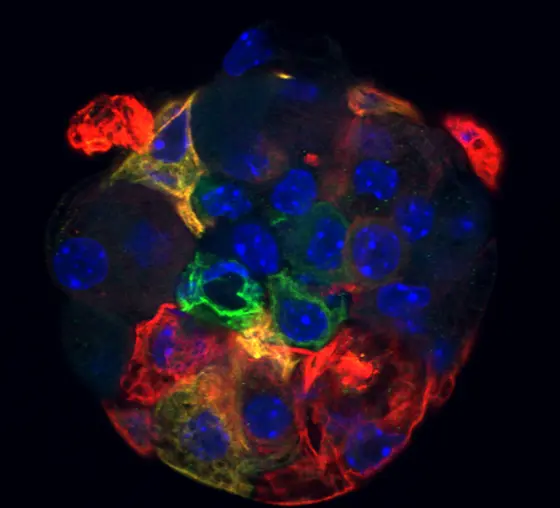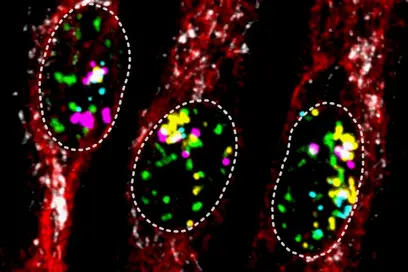Most people do not even know that it exists: the thymus gland, a small organ that lies behind the breast bone. Without it, however, the body could not mount an immune response and would be defenseless against viruses and bacteria, as can be observed in cases of thymus defects.
Cells of the immune system called T cells migrate from the bone marrow into the thymus where they “learn" to discriminate between “non-self" (is attacked) and “self" (is tolerated). Several years ago, Professor Dr. Bruno Kyewski of the German Cancer Research Center (Deutsches Krebsforschungszentrum, DKFZ) showed that a multitude of tissue-specific proteins of the body are formed for this purpose in the thymus gland. These proteins serve as demonstration material for the immature immune cells to learn self-tolerance.
In a process that comprises several stages of maturation and selection, progenitor T cells first pass the cortex and then the medulla of the thymus. These two areas are formed by two distinct lines of thymic epithelial cells (TECs), namely the cortical (cTECs) and the medullary thymic epithelial cells (mTECs).
At the German Cancer Research Center, Ahmet and Olga Ucar and colleagues from the groups headed by Bruno Kyewski and Thomas Hofmann have now been able to prove that both cell types stem from a common progenitor. In the thymus of adult mice, the scientists discovered a rare cell type that exhibits typical properties of stem cells. They used a detection method that is based on the capacity of particular tissue-specific stem cells to form globular structures called spheres, in this case thymus spheres, in the culture dish. The sphere-forming cells divide very slowly, giving rise to a new stem cell (self-renewal) and a progenitor cell of the epithelial thymic cells, which can subsequently go on to develop into mature cTECs and mTECs.
Surprisingly, the thymus stem cells lack a transcription factor called Foxn1 that is considered to be vital for normal thymic epithelial development. Apparently, this transcription factor is not needed until later stages in the development of the TECs.
In the adult human thymus, the researchers in Kyewski’s group also identified a rare cell type that can grow into thymus spheres and which they therefore regard as a stem cell candidate. They now plan to characterize and nourish the potential thymus stem cells. The scientists see a chance for developing a cell therapy using TEC stem cells to correct congenital or acquired thymus defects for treating immune deficiencies or autoimmune diseases.
Ahmet Ucar, Olga Ucar, Paula Klug, Sonja Matt, Fabian Brunk, Thomas G. Hofmann and Bruno Kyewski: The adult thymus contains FoxN1- epithelial stem cells that are bipotent for medullary and cortical thymic epithelial lineages. Immunity 2014, DOI: 10.1016/j.immuni.2014.07.005
About DKFZ
With more than 3,000 employees, the German Cancer Research Center (Deutsches Krebsforschungszentrum, DKFZ) is Germany’s largest biomedical research institute. DKFZ scientists identify cancer risk factors, investigate how cancer progresses and develop new cancer prevention strategies. They are also developing new methods to diagnose tumors more precisely and treat cancer patients more successfully. The DKFZ's Cancer Information Service (KID) provides patients, interested citizens and experts with individual answers to questions relating to cancer.
To transfer promising approaches from cancer research to the clinic and thus improve the prognosis of cancer patients, the DKFZ cooperates with excellent research institutions and university hospitals throughout Germany:
- National Center for Tumor Diseases (NCT, 6 sites)
- German Cancer Consortium (DKTK, 8 sites)
- Hopp Children's Cancer Center (KiTZ) Heidelberg
- Helmholtz Institute for Translational Oncology (HI-TRON Mainz) - A Helmholtz Institute of the DKFZ
- DKFZ-Hector Cancer Institute at the University Medical Center Mannheim
- National Cancer Prevention Center (jointly with German Cancer Aid)
The DKFZ is 90 percent financed by the Federal Ministry of Research, Technology and Space and 10 percent by the state of Baden-Württemberg. The DKFZ is a member of the Helmholtz Association of German Research Centers.



